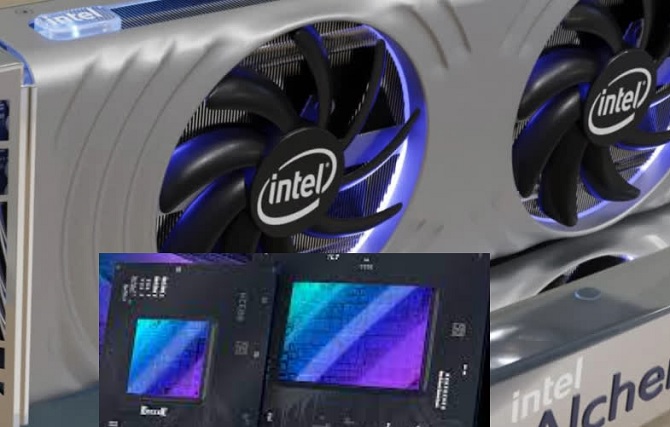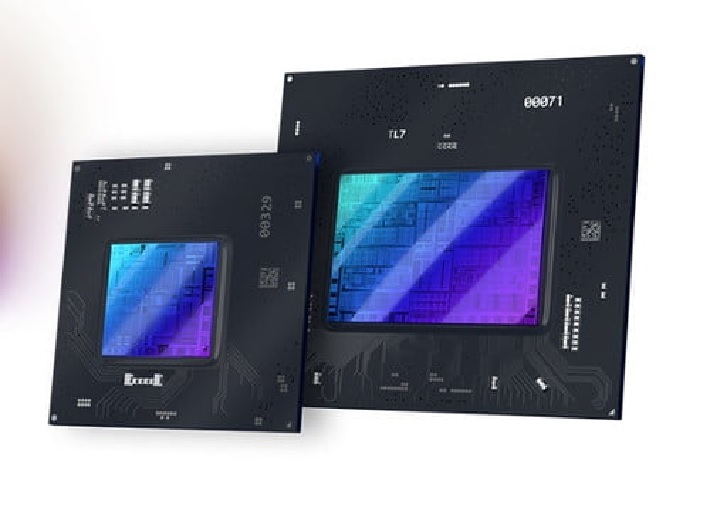Intel’s Arc Alchemist GPUs Rumored To Launch In March, Will Take On The RTX 3060 And 3070

Intel’s ARC Alchemist GPUs High-End Graphics Lineup Is Expected to Launch in March, With DG2-512 16GB and DG2-384 12 GB Models.
We’re hearing more and more rumors about Intel’s ARC Alchemist gaming graphics card series based on the Xe-HPG DG2 GPUs as we approach closer to CES 2022.
According to the latest rumors from Expreview forums (via ITHome), Intel had planned to launch its ARC Alchemist graphics lineup in January 2022, but it was pushed back to the end of Q1 and may even slip into Q2, though this remains to be seen as Intel may have changed its mind and moved the launch forward.
The first ARC Alchemist DG2 GPUs have already been dispatched to key AIB partners for debugging, so one can expect a variety of custom cards to be available alongside the reference ones when the product launches.
In terms of the portfolio itself, Intel is expected to release two ARC Alchemist graphics cards based on the DG2-512 SKU, in addition to the entry-level ARC A380 with the DG2-128 GPU (SOC 2). (SOC 1). The next sections go over the configurations for each Intel ARC Alchemist GPU in great detail:

Intel’s Arc Alchemist GPUs Specifications
| Specifications | Xe-HPG 512EU | Xe-HPG 384EU | Xe-HPG 256EU | Xe-HPG 128EU | Xe-HPG 128EU | Xe-HPG 96EU |
| Graphics Card Variant | ARC A780? | ARC A750? | ARC A580? | ARC A380? | ARC A350? | ARC A330? |
| GPU Die | Alchemist-512EU | Alchemist-512EU | Alchemist-512EU | Alchemist-128EU | Alchemist-128EU | Alchemist-128EU |
| Execution Units | 512 EUs | 384 EUs | 256 EUs | 128 EUs | 128 EUs | 86 EUs |
| Shading Units (Cores) | 4096 | 3072 | 2048 | 1024 | 1024 | 768 |
| Memory Capacity | Up To 32/16 GB GDDR6 | Up To 12 GB GDDR6 | Up To 8 GB GDDR6 | Up To 6 GB GDDR6 | Up To 4 GB GDDR6 | Up To 4 GB GDDR6 |
| Memory Speed | 18 / 16 / 14 Gbps | 16 / 14 Gbps | 16 / 14 Gbps | 16 / 14 Gbps | 16 / 14 Gbps | 16 / 14 Gbps |
| Memory Bus | 256-bit | 192-bit | 128-bit | 96-bit | 64-bit | 64-bit |
| TGP | ~225W (Desktops) 120-150W (Laptops) | 150-200W (Desktops) 80-120W (Laptops) | 60-80W (Laptops) | ~75W (Desktops) | 35-50W (Laptops) | ~35W (Laptops) |
Intel Xe-HPG 512 EU GPUs Powered ARC Alchemist Gaming Graphics Lineup
At least three configurations are claimed to be available for the top Alchemist 512 EU (32 Xe Cores) model. The entire device has 4096 cores, a 256-bit bus interface, and up to 16 GB of GDDR6 memory with a 16 Gbps rate, however, 18 Gbps is possible, according to reports. Based on the DG2-SOC1, users can expect the following ARC 512 EU variants:
- 256 EU (4096 ALUs) / 16 GB @ Up To 18 Gbps / 256-bit / 225W (Desktops) & 120-150W (Laptops)
- 384 EU (3072 ALUs) / 12 GB @ 16 Gbps / 192-bit / 150-200W (Desktops) & 80-120W (Servers) (Laptops)
- 8 GB @ Up To 16 Gbps / 128-bit / 60-80W / 256 EU (2048 ALUs)(Laptops)
Competing With The NVIDIA RTX 3070
Intel is aiming for the high-performance category, despite the fact that it still doesn’t have a response to cards like the NVIDIA RTX 3090. The Intel Arc Alchemist with 512 execution units and 16GB of visual memory (internally known as DG2-512) and a variation with 384 EUs and 12GB are the two main releases anticipated.
In terms of performance, the first option would be to go with an NVIDIA RTX 3070 or 3070 Ti. According to reports, the DG2-384 is designed to compete with the NVIDIA RTX 3060 and 3060 Ti boards.
According to IT Home, Intel Arc Alchemist, which has 128 execution units, is another debut that could shake up the industry. More information on her has lately become available, including a TDP of under 35 watts. It would be able to compete directly with NVIDIA’s recently introduced RTX 2050, which is an intriguing topic.
Intel GPUs Also For Notebooks
It’s worth noting that Intel also intends to introduce the aforementioned processors to the notebook market, with possible tweaks to clocks, memory bandwidth, and, most importantly, power consumption, but with the same number of cores and execution units.
In its desktop version, the Intel DG2-512 should draw between 225 and 270 watts, while in notebooks, it should draw between 120 and 150 watts. The desktop version of the DG2-384 is said to be capable of 150 to 200 watts, while the mobile version is said to be capable of 80 to 120 watts.
There are even smaller versions based on chip variants that promise to shake up the input market. In fact, the Intel competition could be good for customers, as it will result in a larger selection of GPUs and fierce competition in every market sector.
In addition to the boards built in collaboration with third-party assemblers, Intel is anticipated to release standard models, similar to what NVIDIA and AMD have done. The release date has been pushed back to March 2022.
Intel ARC Alchemist vs NVIDIA GA104 & AMD Navi 22 GPUs
| Graphics Card Name | Intel ARC A780? | NVIDIA GeForce RTX 3070 Ti | AMD Radeon RX 6700 XT |
| GPU Name | Alchemist DG-512 | NVIDIA GA104 | AMD Navi 22 |
| Architecture | Xe-HPG | Ampere | RDNA 2 |
| Process Node | TSMC 6nm | Samsung 8nm | TSMC 7nm |
| Die Size | ~396mm2 | 392mm2 | 335mm2 |
| FP32 Cores | 32 Xe Cores | 48 SM Units | 40 Compute Units |
| FP32 Units | 4096 | 6144 | 2560 |
| Memory Bus | 256-bit | 256-bit | 192-bit |
| Memory Capacity | 16 GB GDDR6 | 8 GB GDDR6X | 16 GB GDDR6 |
| Launch | Q1 2022 | Q2 2021 | Q1 2021 |

Intel Xe-HPG 128 EU GPUs Powered ARC Alchemist Gaming Graphics Lineup
Last but not least, the Intel Xe-HPG Alchemist 128 EU (8 Xe Cores) components. The full-fat SKU with 1024 cores is available in two configurations: a 96-bit and a 64-bit edition with 6 GB and 4 GB memory capacity, respectively.
The stripped-down version will include 96 EUs (768 cores) and 4 GB GDDR6 memory on a 64-bit bus interface. The processor will also have a clock speed of roughly 2.2-2.5 GHz and power consumption of less than 75W, implying that entry-level graphics cards will be connector-free.
Based on the DG2-SOC2, users can expect the following ARC 128 EU variants:
- 6 GB @ Up To 16 Gbps / 96-bit / 75W 128 EU (1024 ALUs) (Desktops)
- 4 GB @ Up To 16 Gbps / 64-bit / 128 EU (1024 ALUs) / 35-30W (Laptops)
- 4 GB @ Up To 16 Gbps / 64-bit / 96 EU (768 ALUs) / 35W (Laptops)
Intel ARC Alchemist vs NVIDIA GA106 & AMD Navi 24 GPUs
| Graphics Card Name | Intel ARC A350? | NVIDIA GeForce RTX 2050 | AMD Radeon RX 6500 XT | Intel ARC A380? | NVIDIA GeForce RTX 3050 |
| GPU Name | ARC Alchemist DG2-128 | NVIDIA GA107 | AMD Navi 24 | ARC Alchemist DG2-128 | NVIDIA GA106 |
| Architecture | Xe-HPG | Ampere | RDNA 2 | Xe-HPG | Ampere |
| Process Node | TSMC 6nm | Samsung 8nm | TSMC 7nm | TSMC 6nm | Samsung 8nm |
| Die Size | ~155mm2 | TBC | TBC | ~155mm2 | 276mm2 |
| FP32 Cores | 8 Xe Cores | 16 SM Units | 16 Compute Units | 8 Xe Cores | 24 SM Units |
| FP32 Units | 1024 | 2048 | 1024 | 1024 | 3072 |
| Memory Bus | 64-bit | 64-bit | 64-bit | 96-bit | 128-bit |
| Memory Capacity | 4 GB GDDR6 | 4 GB GDDR6 | 4 GB GDDR6 | 6 GB GDDR6 | 8 GB GDDR6 |
| TDP | 35-50W | 30-45W | ~75W | ~75W | ~75W |
| Launch | Q1 2022 | Q1 2022 | Q2 2022 | Q1 2022 | Q1 2022 |
Conclusion
The Xe-HPG Alchemist portfolio will fight against NVIDIA’s Ampere and AMD’s RDNA 2 GPUs based on the timeframe, as both firms aren’t slated to release their next-gen chips until the end of 2022.
NVIDIA and AMD are slated to announce updates in early 2022, which might give Intel’s new range some competition, although based on current performance projections, the refreshed portfolio is unlikely to offer significant performance differences.
The Xe-HPG ARC GPUs will also be available on the mobility platform, with Alder Lake-P notebooks featuring them. In the guise of ARC Battlemage, Intel will have a proper high-end graphics card range by 2023 to compete against NVIDIA’s Ada Lovelace and AMD RDNA 3 CPUs.
People Also Ask
What is Intel Xe HPG?
Xe-HPG is the final Xe flavor to be unveiled, and it’s aimed to take the technologies and lessons learned from Intel’s prior Xe efforts and turn them into a family of discrete, high-performance gaming and graphics GPUs that can compete with AMD and NVIDIA.
How Much VRAM Does Intel Xe Have?
The Iris Xe desktop graphics card, also known as the DG1, has been announced by Intel. Only OEMs will be able to purchase the Iris Xe Graphics, which has a 30 W TDP and 4 GB of VRAM. NVIDIA’s cheap cards, such as the Pascal-based GeForce GT 1010, will most likely compete with the Iris Xe DG1.
Is Intel GPU Good For Gaming?
Because onboard graphics, such as Intel HD Graphics, aren’t built for high-end gaming, people will have to dial down the settings if they really want to play recent games. Even if people have a low-powered laptop with Intel HD Graphics built-in, one can play a surprising amount of games.
- AMD 6nm Navi 24 GPU Based RX 6500 XT And RX 6400 Launch Next Month
- EVGA GeForce RTX 3090 FTW3 Ultra Gaming Graphics Card Drops to $1349 at Amazon
- Alienware Intel i7 Alder Lake DDR5 RTX 3080 Gaming PC
Is Intel Xe Discrete?
Intel is stating that its first-generation discrete graphics using the Xe-HPG architecture will be on stores in Q1 2022, which is normally a chance to hoist the flag of invention about what’s to come.
What CPUs Have XE Graphics?
While this may appear to be a strange move, Intel anticipates their fastest processors to include separate graphics from AMD or Nvidia, making the integrated graphics solution obsolete. That leaves the Intel Xe-branded 11th-generation Core i5 and i7 quad-core CPUs as your only option.






